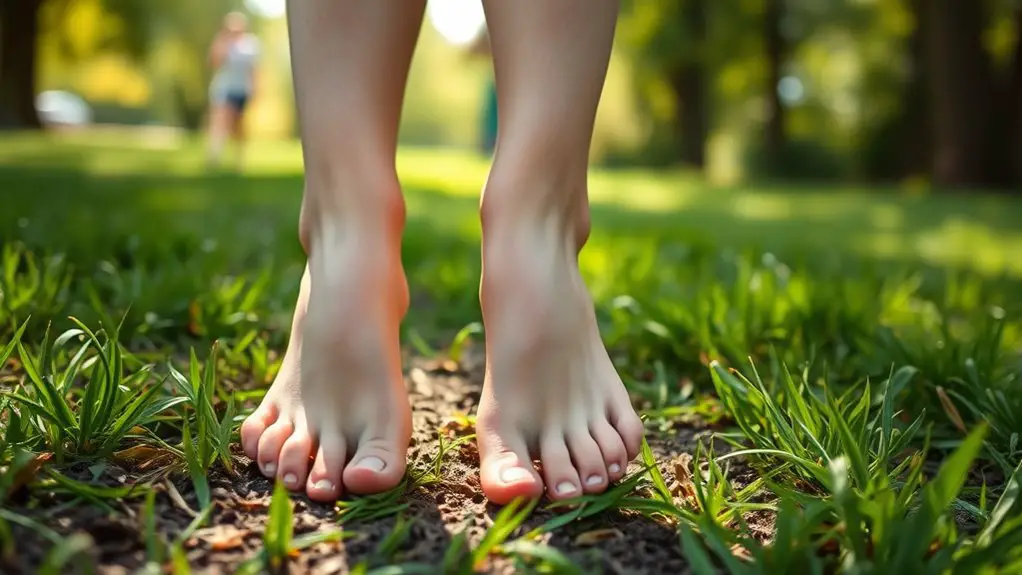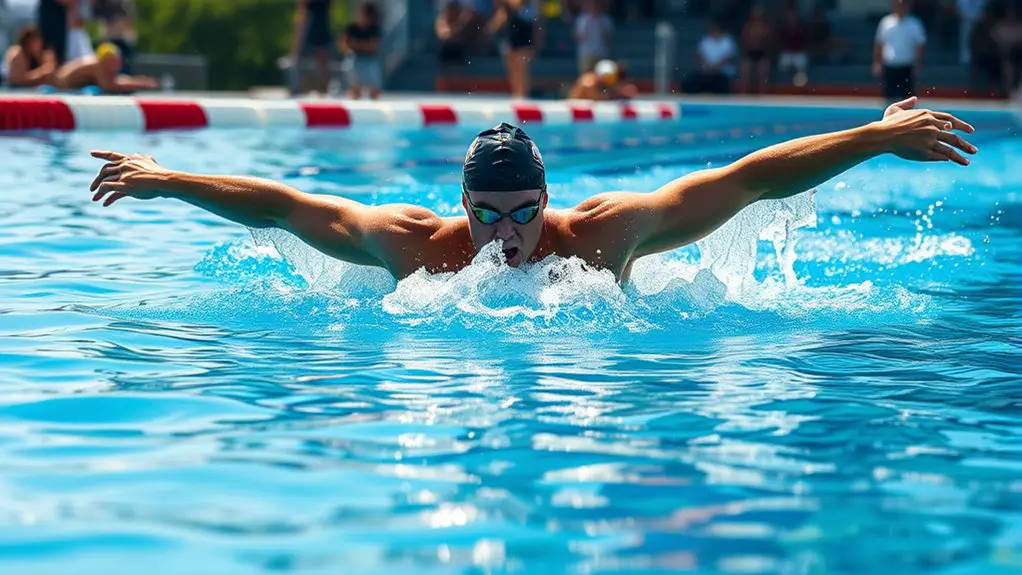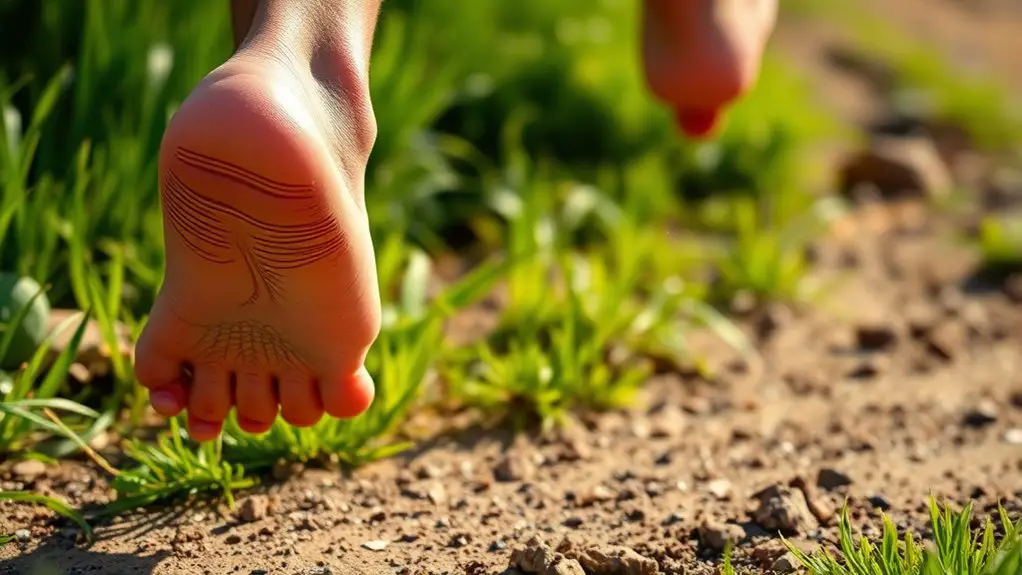To shift safely into barefoot running, start by evaluating your current running technique and ensuring proper alignment. Choose lightweight, flexible shoes to support your journey. Use the 10% rule to gradually increase distance, allowing your muscles to adapt. Pay attention to your body, noting any discomfort or pain. Incorporate strength and flexibility training to build foot strength. Keep track of your progress and adjust your plan as needed. Discover more tips to enhance your shift.
Understanding the Benefits of Barefoot Running
When you consider switching to barefoot running, you might be surprised by the numerous benefits it offers. Embracing this natural style can lead to incredible health benefits, including improved foot strength and injury prevention. By allowing your feet to connect with the ground, you enhance proprioception, which helps you become more aware of your body's movements. This heightened awareness can lead to improved posture and more efficient running mechanics, aligning with your natural biomechanics.
You'll also enjoy greater sensory feedback as your feet interact with various surfaces, fostering a deeper connection to the ground beneath you. This freedom not only promotes a natural running experience but also empowers you to listen to your body and adapt to its needs. By shifting to barefoot running, you're not just changing your footwear; you're embracing a lifestyle that champions strength, awareness, and a profound connection to the earth.
Assessing Your Current Running Technique
How effectively are you running? To shift into barefoot running, it's essential to assess your current running technique. Start by examining your running posture. Are you upright, with a relaxed body, or hunched over? Proper posture can enhance your efficiency and reduce the risk of injury. Next, evaluate your foot strike. Are you landing on your heel, midfoot, or forefoot? Most barefoot runners benefit from a midfoot to forefoot strike, which encourages a more natural gait.
Take some time to record yourself running or run on a soft surface. Notice how your body moves—this awareness is key. If you feel tension or discomfort, it might signal that a change is necessary. Embracing a freer, more fluid running style will prepare you for the barefoot experience ahead, allowing you to connect with the ground beneath you and enjoy every stride. Additionally, focusing on proper alignment fosters efficiency and reduces strain, which is crucial during your transition.
Choosing the Right Barefoot or Minimalist Shoes
After evaluating your running technique, the next step is finding the right footwear to support your new approach. Choosing barefoot or minimalist shoes means prioritizing comfort and freedom. Look for lightweight shoe materials that allow your feet to move naturally. Breathable fabrics can help keep your feet cool, while flexible soles let you feel the ground beneath you.
Fit considerations are significant; you want a snug, yet not restrictive fit. Your toes should have space to splay naturally, so avoid shoes that pinch. It's also essential to take into account the width of your foot—some brands cater to narrow or wide feet.
Ultimately, you're searching for a pair that feels like an extension of your body. Test different styles and take your time. The right shoes will make your shift to barefoot running enjoyable and liberating, allowing you to reconnect with the joy of running. Additionally, staying hydrated is crucial for maintaining energy levels and performance during your transition to barefoot running, as proper hydration helps avoid fatigue.
Gradual Transition: The 10% Rule
As you begin your shift to barefoot running, it is crucial to follow the 10% rule to prevent injuries and allow your body to adapt. This means you should increase your running distance or time in 10% increments each week. By doing this, you enable your muscles and tendons to adjust gradually, reducing the risk of overuse injuries. It's all about listening to your body; if you feel discomfort, it's okay to scale back.
Start with short runs, focusing on form and comfort. As your feet grow stronger and more accustomed to the minimalist feel, you can gradually increase your distance. This gradual adaptation helps you embrace the freedom of barefoot running without overwhelming your body. Remember, the journey is just as important as the destination. Enjoy the process, and trust that each step forward is a step towards a more natural running experience. Additionally, incorporating rest days into your training is essential for allowing muscle recovery and avoiding burnout.
Incorporating Strength and Flexibility Training
Incorporating strength and flexibility training into your routine is essential for a successful change to barefoot running. By building strength and enhancing flexibility, you'll empower your feet and lower body, making your running experience more enjoyable and injury-free. Strengthening stabilizer muscles is particularly important as it helps maintain balance and support during your transition.
| Strength ExercisesFlexibility Routines | |
|---|---|
| Bodyweight squats | Standing calf stretch |
| Lunges | Hamstring stretch |
| Heel raises | Hip flexor stretch |
| Glute bridges | Quadriceps stretch |
| Single-leg balance | Ankle mobility exercises |
Aim to integrate these exercises and routines at least two to three times a week. This approach not only supports your change but also fosters a sense of freedom, allowing your body to adapt and thrive in a more natural running style. Enjoy the journey, and let your feet rediscover their strength!
Listening to Your Body: Signs of Overuse
As you shift to barefoot running, it's essential to pay attention to your body's signals. If you're feeling persistent pain or unusual fatigue, those are signs you shouldn't ignore. Listening to these cues can help prevent overuse injuries and keep your running enjoyable. Incorporating proper warm-ups into your routine can also significantly reduce the risk of overuse injuries.
Recognizing Pain Signals
Recognizing pain signals is essential for anyone shifting to barefoot running. Your body communicates through discomfort, and it's vital to listen. Ignoring these signals can lead to injuries that shackle your running freedom. Here are three key pain recognition tips for injury prevention:
- Sharp Pain: If you feel a sudden, sharp pain, it's your body's way of saying "stop." Pay attention and rest.
- Persistent Discomfort: A dull ache that lingers post-run might indicate overuse. Scale back your distance and intensity.
- Swelling or Redness: These signs often signal inflammation. Ice and elevate the affected area, and consider consulting a professional.
Being attuned to your body will keep your running journey enjoyable and sustainable.
Monitoring Fatigue Levels
Listening to your body goes beyond just pain; monitoring fatigue levels is equally important when shifting to barefoot running. Fatigue monitoring helps you gauge how your body responds to this new freedom. You may feel excited to run, but if you're consistently drained, it's a sign to slow down. Pay attention to how your energy fluctuates during and after runs. If you're feeling unusually tired, it's essential to manage that energy wisely and adjust your routine. Consider incorporating rest days or cross-training to balance your efforts. Embrace this journey, but remember: respecting your body's limits is part of finding that ultimate joy in barefoot running. Tune into your fatigue, and you'll enjoy a safer, more liberating experience.
Tracking Your Progress and Adjusting Your Plan
While shifting to barefoot running, it's essential to track your progress and adjust your plan accordingly. Embracing this new running style can be liberating, but you'll want to make sure you're moving in the right direction. Here are three key progress metrics to keep in mind:
Tracking your progress is crucial when transitioning to barefoot running; ensure you're adapting positively and enjoying the journey.
- Distance and Duration: Gradually increase your running distance and time while monitoring how your body responds.
- Foot Pain or Discomfort: Note any pain levels and areas of discomfort, adjusting your mileage as needed.
- Running Form: Record improvements in your form to make sure you're adapting correctly and efficiently to barefoot running.
Utilizing these adjustment strategies will help you stay on track and maintain your freedom on the road or trail. Listen to your body and be flexible with your plan; your journey into barefoot running should feel natural and enjoyable, not forced.
Frequently Asked Questions
Can Barefoot Running Help Improve My Overall Running Speed?
Barefoot running can definitely help improve your overall running speed. It encourages a more natural stride and enhances running efficiency, allowing you to move more freely. When you adapt to running without shoes, you'll likely develop stronger foot and leg muscles, which can boost your speed over time. Just remember to listen to your body; gradual adaptation is key, and you'll find that freedom in your stride can lead to impressive gains.
What Types of Surfaces Are Best for Barefoot Running?
When you're exploring barefoot running, you'll find that grass trails and sandy beaches are some of the best surfaces to enjoy. They're soft, forgiving, and let your feet move naturally, giving you that freedom you crave. Running on these surfaces can help you connect with the ground, enhancing your experience. Just remember to start slow, letting your feet adjust to these new sensations while you revel in the joy of running freely.
How Do I Choose the Right Socks for Barefoot Running?
When it comes to choosing the right socks for barefoot running, you've gotta strike while the iron's hot! Look for sock materials that offer breathability and moisture management to keep your feet dry and comfortable. Lightweight, synthetic fabrics are ideal, as they allow freedom of movement and prevent blisters. Avoid anything too thick or cushioned, since you want to feel connected to the ground. With the right socks, you'll enjoy every step of your run!
Are There Age Restrictions for Starting Barefoot Running?
There aren't strict age restrictions for starting barefoot running, but age considerations are important. Whether you're young or older, the benefits of barefoot running can be amazing, enhancing strength and balance. However, if you're new to it, start gradually to avoid injury. Listen to your body, and don't push too hard too fast. Embracing this freedom in movement can be transformative, but it's key to respect your own limits and experience.
Can Barefoot Running Help With Specific Injuries or Conditions?
So, you think barefoot running's just a trendy fad? Well, it might actually help with injury recovery! You'll find that ditching those clunky shoes can offer biomechanical benefits, allowing your feet to strengthen naturally. As you embrace the freedom of running barefoot, you may notice improvements in alignment and balance. Just remember, it's not a miracle cure; take it slow and listen to your body. Who knew freedom could come with a little caution?




